Impact of Training & Development on Employee Productivity at Next PLC
VerifiedAdded on 2023/01/12
|9
|2224
|80
Project
AI Summary
This dissertation proposal investigates the impact of training and development on employee productivity, using Next PLC as a case study. The proposal outlines the background, research rationale, and research questions, aiming to determine the benefits of training and development in an organizational context and identify how training influences employee productivity. The methodology includes a deductive research approach, employing a survey strategy with quantitative methods and questionnaires as research tools, with a sample size of 30 respondents. The proposal details the sampling method, timescale, and resources required, including the use of MS Excel for data analysis. The study seeks to understand the relationship between training and employee performance, contributing to the field of human resource management and organizational effectiveness.

DISSERTATION
PROPOSAL
PROPOSAL
Paraphrase This Document
Need a fresh take? Get an instant paraphrase of this document with our AI Paraphraser
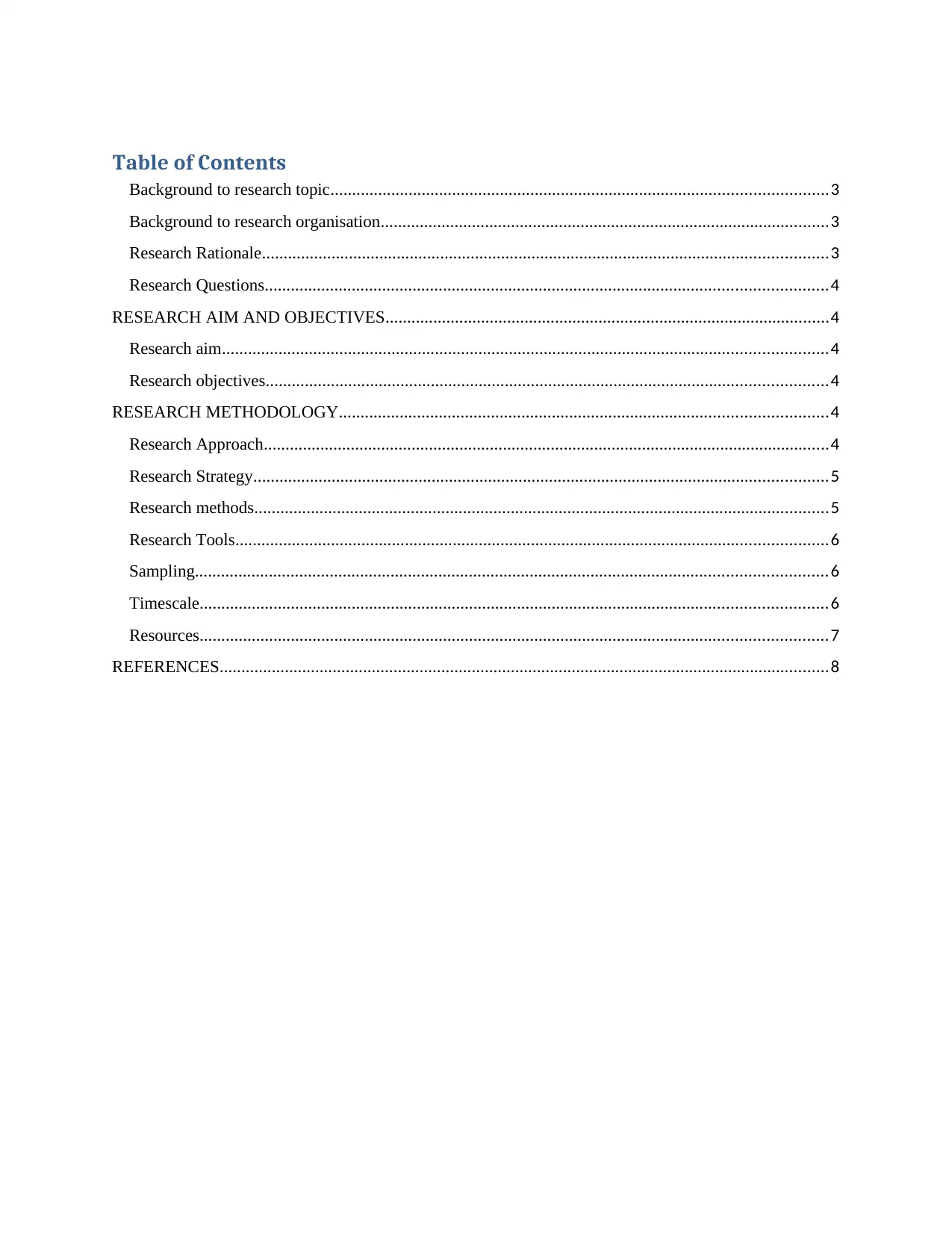
Table of Contents
Background to research topic..................................................................................................................3
Background to research organisation.......................................................................................................3
Research Rationale..................................................................................................................................3
Research Questions.................................................................................................................................4
RESEARCH AIM AND OBJECTIVES......................................................................................................4
Research aim...........................................................................................................................................4
Research objectives.................................................................................................................................4
RESEARCH METHODOLOGY................................................................................................................4
Research Approach..................................................................................................................................4
Research Strategy....................................................................................................................................5
Research methods....................................................................................................................................5
Research Tools........................................................................................................................................6
Sampling.................................................................................................................................................6
Timescale................................................................................................................................................6
Resources................................................................................................................................................7
REFERENCES............................................................................................................................................8
Background to research topic..................................................................................................................3
Background to research organisation.......................................................................................................3
Research Rationale..................................................................................................................................3
Research Questions.................................................................................................................................4
RESEARCH AIM AND OBJECTIVES......................................................................................................4
Research aim...........................................................................................................................................4
Research objectives.................................................................................................................................4
RESEARCH METHODOLOGY................................................................................................................4
Research Approach..................................................................................................................................4
Research Strategy....................................................................................................................................5
Research methods....................................................................................................................................5
Research Tools........................................................................................................................................6
Sampling.................................................................................................................................................6
Timescale................................................................................................................................................6
Resources................................................................................................................................................7
REFERENCES............................................................................................................................................8
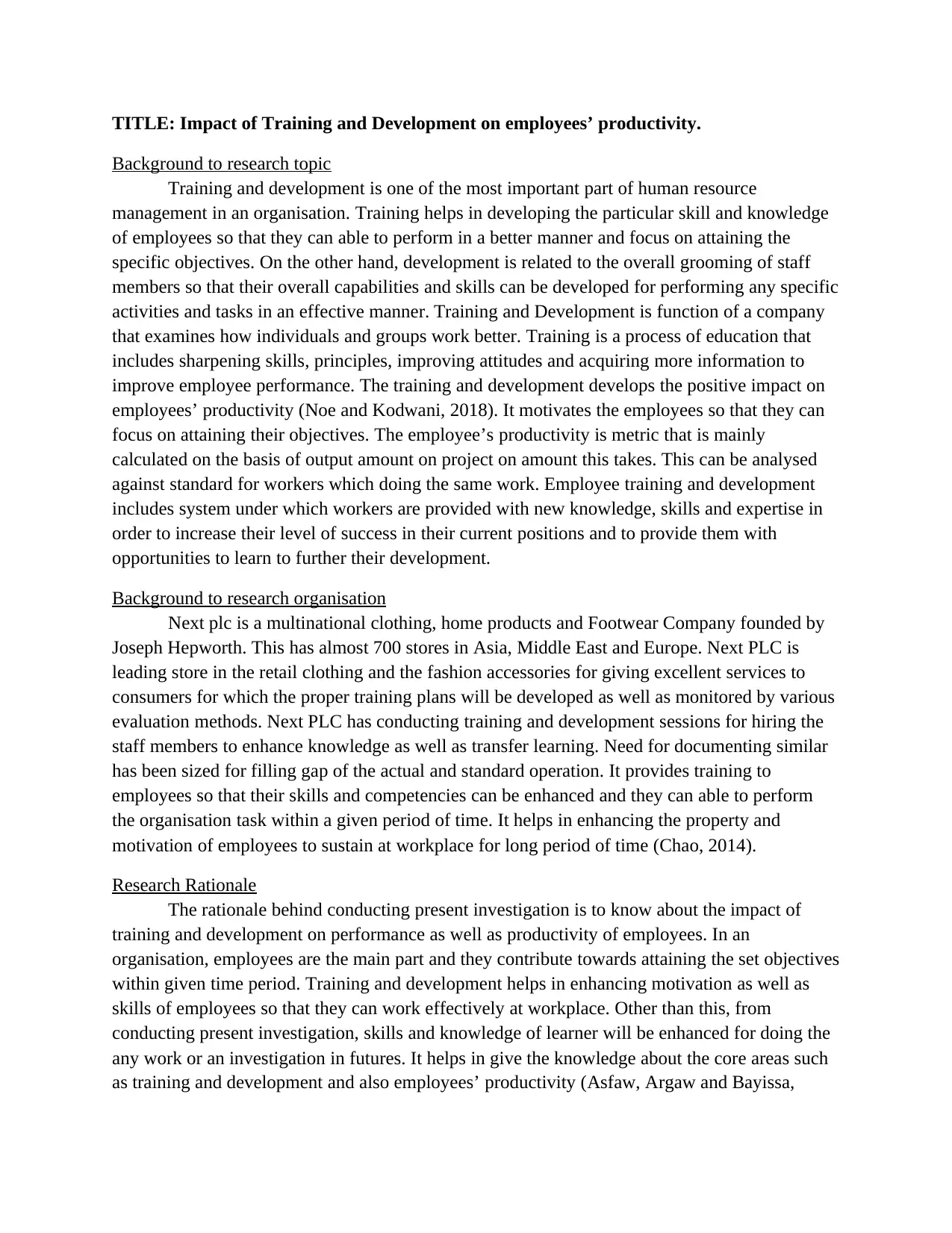
TITLE: Impact of Training and Development on employees’ productivity.
Background to research topic
Training and development is one of the most important part of human resource
management in an organisation. Training helps in developing the particular skill and knowledge
of employees so that they can able to perform in a better manner and focus on attaining the
specific objectives. On the other hand, development is related to the overall grooming of staff
members so that their overall capabilities and skills can be developed for performing any specific
activities and tasks in an effective manner. Training and Development is function of a company
that examines how individuals and groups work better. Training is a process of education that
includes sharpening skills, principles, improving attitudes and acquiring more information to
improve employee performance. The training and development develops the positive impact on
employees’ productivity (Noe and Kodwani, 2018). It motivates the employees so that they can
focus on attaining their objectives. The employee’s productivity is metric that is mainly
calculated on the basis of output amount on project on amount this takes. This can be analysed
against standard for workers which doing the same work. Employee training and development
includes system under which workers are provided with new knowledge, skills and expertise in
order to increase their level of success in their current positions and to provide them with
opportunities to learn to further their development.
Background to research organisation
Next plc is a multinational clothing, home products and Footwear Company founded by
Joseph Hepworth. This has almost 700 stores in Asia, Middle East and Europe. Next PLC is
leading store in the retail clothing and the fashion accessories for giving excellent services to
consumers for which the proper training plans will be developed as well as monitored by various
evaluation methods. Next PLC has conducting training and development sessions for hiring the
staff members to enhance knowledge as well as transfer learning. Need for documenting similar
has been sized for filling gap of the actual and standard operation. It provides training to
employees so that their skills and competencies can be enhanced and they can able to perform
the organisation task within a given period of time. It helps in enhancing the property and
motivation of employees to sustain at workplace for long period of time (Chao, 2014).
Research Rationale
The rationale behind conducting present investigation is to know about the impact of
training and development on performance as well as productivity of employees. In an
organisation, employees are the main part and they contribute towards attaining the set objectives
within given time period. Training and development helps in enhancing motivation as well as
skills of employees so that they can work effectively at workplace. Other than this, from
conducting present investigation, skills and knowledge of learner will be enhanced for doing the
any work or an investigation in futures. It helps in give the knowledge about the core areas such
as training and development and also employees’ productivity (Asfaw, Argaw and Bayissa,
Background to research topic
Training and development is one of the most important part of human resource
management in an organisation. Training helps in developing the particular skill and knowledge
of employees so that they can able to perform in a better manner and focus on attaining the
specific objectives. On the other hand, development is related to the overall grooming of staff
members so that their overall capabilities and skills can be developed for performing any specific
activities and tasks in an effective manner. Training and Development is function of a company
that examines how individuals and groups work better. Training is a process of education that
includes sharpening skills, principles, improving attitudes and acquiring more information to
improve employee performance. The training and development develops the positive impact on
employees’ productivity (Noe and Kodwani, 2018). It motivates the employees so that they can
focus on attaining their objectives. The employee’s productivity is metric that is mainly
calculated on the basis of output amount on project on amount this takes. This can be analysed
against standard for workers which doing the same work. Employee training and development
includes system under which workers are provided with new knowledge, skills and expertise in
order to increase their level of success in their current positions and to provide them with
opportunities to learn to further their development.
Background to research organisation
Next plc is a multinational clothing, home products and Footwear Company founded by
Joseph Hepworth. This has almost 700 stores in Asia, Middle East and Europe. Next PLC is
leading store in the retail clothing and the fashion accessories for giving excellent services to
consumers for which the proper training plans will be developed as well as monitored by various
evaluation methods. Next PLC has conducting training and development sessions for hiring the
staff members to enhance knowledge as well as transfer learning. Need for documenting similar
has been sized for filling gap of the actual and standard operation. It provides training to
employees so that their skills and competencies can be enhanced and they can able to perform
the organisation task within a given period of time. It helps in enhancing the property and
motivation of employees to sustain at workplace for long period of time (Chao, 2014).
Research Rationale
The rationale behind conducting present investigation is to know about the impact of
training and development on performance as well as productivity of employees. In an
organisation, employees are the main part and they contribute towards attaining the set objectives
within given time period. Training and development helps in enhancing motivation as well as
skills of employees so that they can work effectively at workplace. Other than this, from
conducting present investigation, skills and knowledge of learner will be enhanced for doing the
any work or an investigation in futures. It helps in give the knowledge about the core areas such
as training and development and also employees’ productivity (Asfaw, Argaw and Bayissa,
⊘ This is a preview!⊘
Do you want full access?
Subscribe today to unlock all pages.

Trusted by 1+ million students worldwide
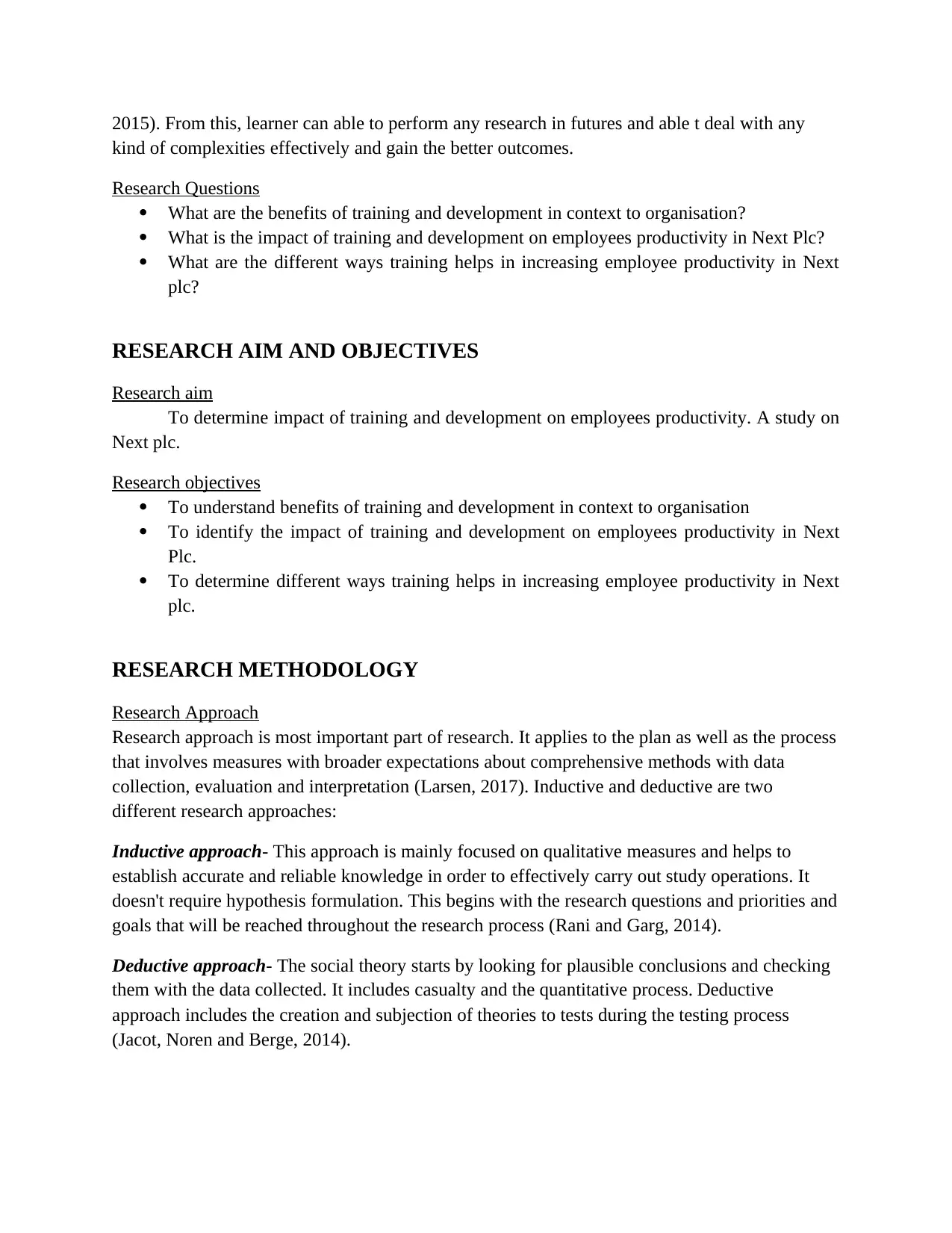
2015). From this, learner can able to perform any research in futures and able t deal with any
kind of complexities effectively and gain the better outcomes.
Research Questions
What are the benefits of training and development in context to organisation?
What is the impact of training and development on employees productivity in Next Plc?
What are the different ways training helps in increasing employee productivity in Next
plc?
RESEARCH AIM AND OBJECTIVES
Research aim
To determine impact of training and development on employees productivity. A study on
Next plc.
Research objectives
To understand benefits of training and development in context to organisation
To identify the impact of training and development on employees productivity in Next
Plc.
To determine different ways training helps in increasing employee productivity in Next
plc.
RESEARCH METHODOLOGY
Research Approach
Research approach is most important part of research. It applies to the plan as well as the process
that involves measures with broader expectations about comprehensive methods with data
collection, evaluation and interpretation (Larsen, 2017). Inductive and deductive are two
different research approaches:
Inductive approach- This approach is mainly focused on qualitative measures and helps to
establish accurate and reliable knowledge in order to effectively carry out study operations. It
doesn't require hypothesis formulation. This begins with the research questions and priorities and
goals that will be reached throughout the research process (Rani and Garg, 2014).
Deductive approach- The social theory starts by looking for plausible conclusions and checking
them with the data collected. It includes casualty and the quantitative process. Deductive
approach includes the creation and subjection of theories to tests during the testing process
(Jacot, Noren and Berge, 2014).
kind of complexities effectively and gain the better outcomes.
Research Questions
What are the benefits of training and development in context to organisation?
What is the impact of training and development on employees productivity in Next Plc?
What are the different ways training helps in increasing employee productivity in Next
plc?
RESEARCH AIM AND OBJECTIVES
Research aim
To determine impact of training and development on employees productivity. A study on
Next plc.
Research objectives
To understand benefits of training and development in context to organisation
To identify the impact of training and development on employees productivity in Next
Plc.
To determine different ways training helps in increasing employee productivity in Next
plc.
RESEARCH METHODOLOGY
Research Approach
Research approach is most important part of research. It applies to the plan as well as the process
that involves measures with broader expectations about comprehensive methods with data
collection, evaluation and interpretation (Larsen, 2017). Inductive and deductive are two
different research approaches:
Inductive approach- This approach is mainly focused on qualitative measures and helps to
establish accurate and reliable knowledge in order to effectively carry out study operations. It
doesn't require hypothesis formulation. This begins with the research questions and priorities and
goals that will be reached throughout the research process (Rani and Garg, 2014).
Deductive approach- The social theory starts by looking for plausible conclusions and checking
them with the data collected. It includes casualty and the quantitative process. Deductive
approach includes the creation and subjection of theories to tests during the testing process
(Jacot, Noren and Berge, 2014).
Paraphrase This Document
Need a fresh take? Get an instant paraphrase of this document with our AI Paraphraser
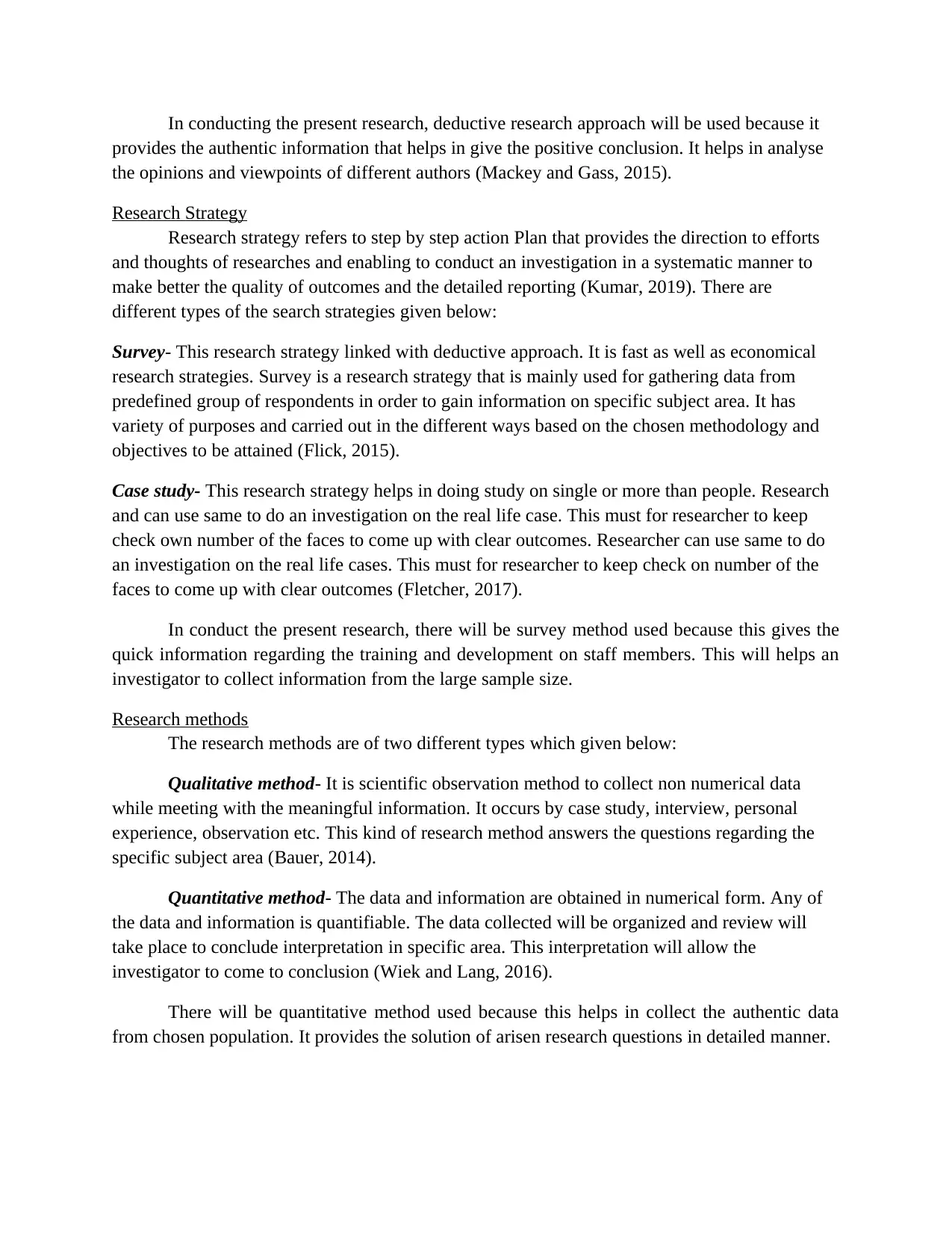
In conducting the present research, deductive research approach will be used because it
provides the authentic information that helps in give the positive conclusion. It helps in analyse
the opinions and viewpoints of different authors (Mackey and Gass, 2015).
Research Strategy
Research strategy refers to step by step action Plan that provides the direction to efforts
and thoughts of researches and enabling to conduct an investigation in a systematic manner to
make better the quality of outcomes and the detailed reporting (Kumar, 2019). There are
different types of the search strategies given below:
Survey- This research strategy linked with deductive approach. It is fast as well as economical
research strategies. Survey is a research strategy that is mainly used for gathering data from
predefined group of respondents in order to gain information on specific subject area. It has
variety of purposes and carried out in the different ways based on the chosen methodology and
objectives to be attained (Flick, 2015).
Case study- This research strategy helps in doing study on single or more than people. Research
and can use same to do an investigation on the real life case. This must for researcher to keep
check own number of the faces to come up with clear outcomes. Researcher can use same to do
an investigation on the real life cases. This must for researcher to keep check on number of the
faces to come up with clear outcomes (Fletcher, 2017).
In conduct the present research, there will be survey method used because this gives the
quick information regarding the training and development on staff members. This will helps an
investigator to collect information from the large sample size.
Research methods
The research methods are of two different types which given below:
Qualitative method- It is scientific observation method to collect non numerical data
while meeting with the meaningful information. It occurs by case study, interview, personal
experience, observation etc. This kind of research method answers the questions regarding the
specific subject area (Bauer, 2014).
Quantitative method- The data and information are obtained in numerical form. Any of
the data and information is quantifiable. The data collected will be organized and review will
take place to conclude interpretation in specific area. This interpretation will allow the
investigator to come to conclusion (Wiek and Lang, 2016).
There will be quantitative method used because this helps in collect the authentic data
from chosen population. It provides the solution of arisen research questions in detailed manner.
provides the authentic information that helps in give the positive conclusion. It helps in analyse
the opinions and viewpoints of different authors (Mackey and Gass, 2015).
Research Strategy
Research strategy refers to step by step action Plan that provides the direction to efforts
and thoughts of researches and enabling to conduct an investigation in a systematic manner to
make better the quality of outcomes and the detailed reporting (Kumar, 2019). There are
different types of the search strategies given below:
Survey- This research strategy linked with deductive approach. It is fast as well as economical
research strategies. Survey is a research strategy that is mainly used for gathering data from
predefined group of respondents in order to gain information on specific subject area. It has
variety of purposes and carried out in the different ways based on the chosen methodology and
objectives to be attained (Flick, 2015).
Case study- This research strategy helps in doing study on single or more than people. Research
and can use same to do an investigation on the real life case. This must for researcher to keep
check own number of the faces to come up with clear outcomes. Researcher can use same to do
an investigation on the real life cases. This must for researcher to keep check on number of the
faces to come up with clear outcomes (Fletcher, 2017).
In conduct the present research, there will be survey method used because this gives the
quick information regarding the training and development on staff members. This will helps an
investigator to collect information from the large sample size.
Research methods
The research methods are of two different types which given below:
Qualitative method- It is scientific observation method to collect non numerical data
while meeting with the meaningful information. It occurs by case study, interview, personal
experience, observation etc. This kind of research method answers the questions regarding the
specific subject area (Bauer, 2014).
Quantitative method- The data and information are obtained in numerical form. Any of
the data and information is quantifiable. The data collected will be organized and review will
take place to conclude interpretation in specific area. This interpretation will allow the
investigator to come to conclusion (Wiek and Lang, 2016).
There will be quantitative method used because this helps in collect the authentic data
from chosen population. It provides the solution of arisen research questions in detailed manner.

Research Tools
In conducting the present investigation, there will be questionnaire used as a research tool for
Collection of data. Question is set of the written or printed questions which choice of the answers
that device for purpose of conducting a survey. This kind of instrument consists series of the
question for collecting information from selected respondents. Research questions mainly mix of
close ended and the open ended question (Mohajan, 2018). In the present investigation there will
be different questions will be developed in questionnaire on the basis of impact of training and
development on employee’s productivity and filling that questionnaire from 30 respondents.
Sampling
Its focus on choosing sample size from the entire population. Sampling is commonly used
in statistical analysis, where the specified number of observations is taken from the large
population. Probabilistic and non- probabilistic are two sampling methods:
Probabilistic sampling- It is based on the assumption that each member of population has known
or equal probability of being chosen. It is sampling technique under which sample from large
size population are mainly selected using method on the basis of probability. The sampling is
mainly used in some of form of the Random selection (Dumay and Cai, 2015).
Non- Probabilistic sampling- This sampling technique for of any member being chosen
for sample cannot calculated. In the sampling technique investigator chosen samples on the basis
of subjective judgement of an investigator rather than the random selection. This is mainly
carried out through observation and investigator uses this widely qualitative research.
In present research, probabilistic sampling will be used by considering the random
sampling. The main reason behind selecting this research sampling is that it gives the equal
chance to chosen respondents. There will be 30 respondents chosen and they are the managers of
company.
Timescale
In conducting the present investigation, there will be questionnaire used as a research tool for
Collection of data. Question is set of the written or printed questions which choice of the answers
that device for purpose of conducting a survey. This kind of instrument consists series of the
question for collecting information from selected respondents. Research questions mainly mix of
close ended and the open ended question (Mohajan, 2018). In the present investigation there will
be different questions will be developed in questionnaire on the basis of impact of training and
development on employee’s productivity and filling that questionnaire from 30 respondents.
Sampling
Its focus on choosing sample size from the entire population. Sampling is commonly used
in statistical analysis, where the specified number of observations is taken from the large
population. Probabilistic and non- probabilistic are two sampling methods:
Probabilistic sampling- It is based on the assumption that each member of population has known
or equal probability of being chosen. It is sampling technique under which sample from large
size population are mainly selected using method on the basis of probability. The sampling is
mainly used in some of form of the Random selection (Dumay and Cai, 2015).
Non- Probabilistic sampling- This sampling technique for of any member being chosen
for sample cannot calculated. In the sampling technique investigator chosen samples on the basis
of subjective judgement of an investigator rather than the random selection. This is mainly
carried out through observation and investigator uses this widely qualitative research.
In present research, probabilistic sampling will be used by considering the random
sampling. The main reason behind selecting this research sampling is that it gives the equal
chance to chosen respondents. There will be 30 respondents chosen and they are the managers of
company.
Timescale
⊘ This is a preview!⊘
Do you want full access?
Subscribe today to unlock all pages.

Trusted by 1+ million students worldwide
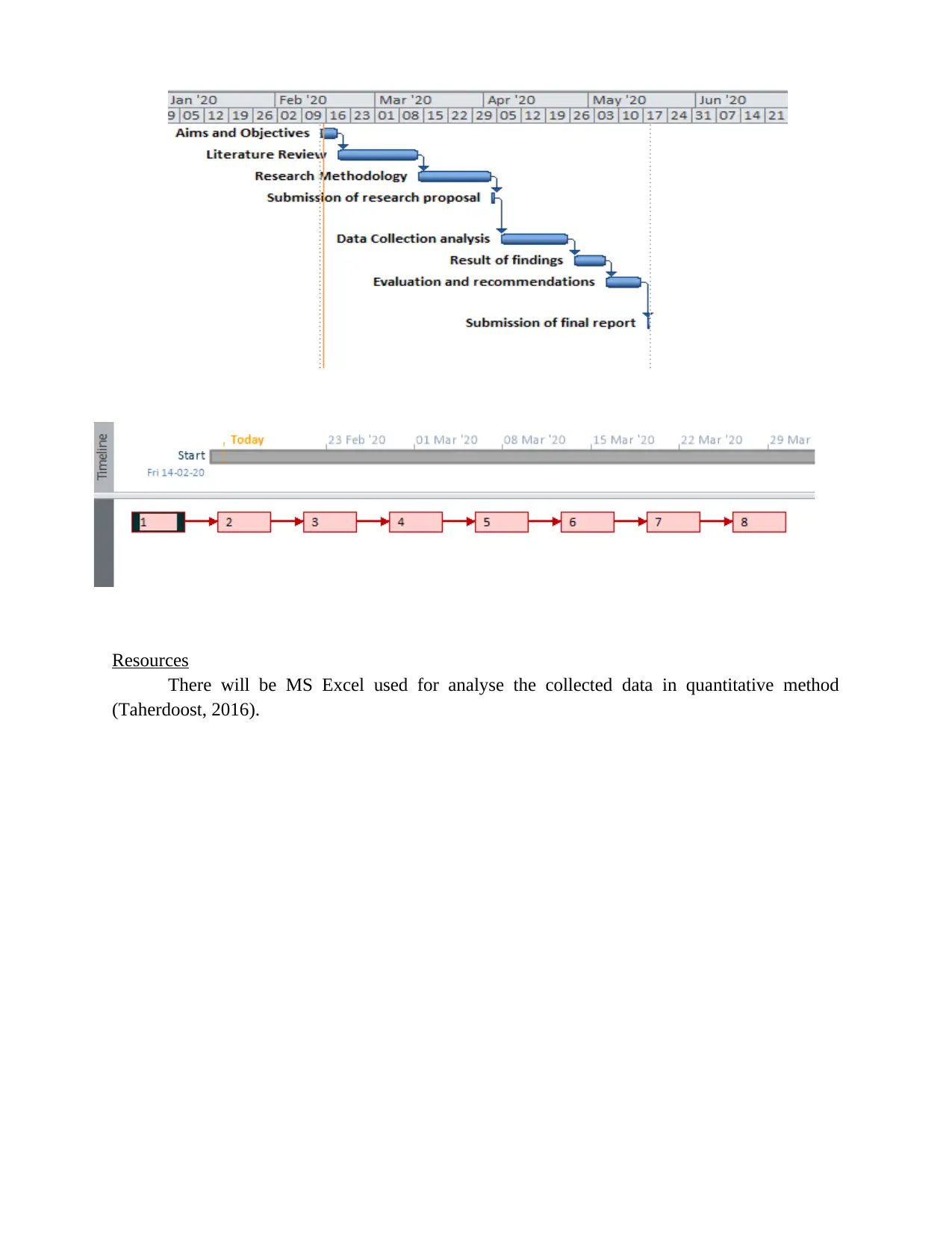
Resources
There will be MS Excel used for analyse the collected data in quantitative method
(Taherdoost, 2016).
There will be MS Excel used for analyse the collected data in quantitative method
(Taherdoost, 2016).
Paraphrase This Document
Need a fresh take? Get an instant paraphrase of this document with our AI Paraphraser
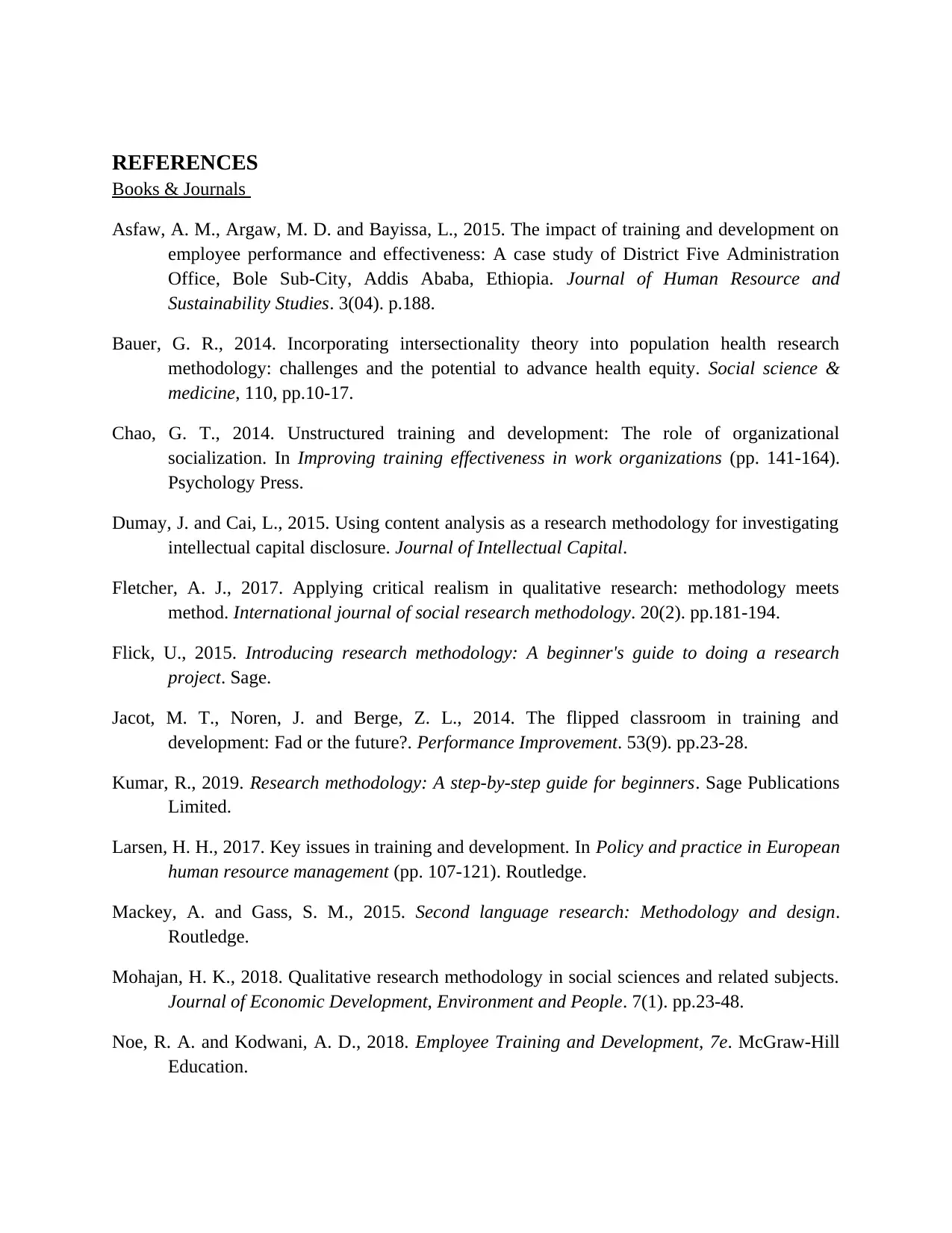
REFERENCES
Books & Journals
Asfaw, A. M., Argaw, M. D. and Bayissa, L., 2015. The impact of training and development on
employee performance and effectiveness: A case study of District Five Administration
Office, Bole Sub-City, Addis Ababa, Ethiopia. Journal of Human Resource and
Sustainability Studies. 3(04). p.188.
Bauer, G. R., 2014. Incorporating intersectionality theory into population health research
methodology: challenges and the potential to advance health equity. Social science &
medicine, 110, pp.10-17.
Chao, G. T., 2014. Unstructured training and development: The role of organizational
socialization. In Improving training effectiveness in work organizations (pp. 141-164).
Psychology Press.
Dumay, J. and Cai, L., 2015. Using content analysis as a research methodology for investigating
intellectual capital disclosure. Journal of Intellectual Capital.
Fletcher, A. J., 2017. Applying critical realism in qualitative research: methodology meets
method. International journal of social research methodology. 20(2). pp.181-194.
Flick, U., 2015. Introducing research methodology: A beginner's guide to doing a research
project. Sage.
Jacot, M. T., Noren, J. and Berge, Z. L., 2014. The flipped classroom in training and
development: Fad or the future?. Performance Improvement. 53(9). pp.23-28.
Kumar, R., 2019. Research methodology: A step-by-step guide for beginners. Sage Publications
Limited.
Larsen, H. H., 2017. Key issues in training and development. In Policy and practice in European
human resource management (pp. 107-121). Routledge.
Mackey, A. and Gass, S. M., 2015. Second language research: Methodology and design.
Routledge.
Mohajan, H. K., 2018. Qualitative research methodology in social sciences and related subjects.
Journal of Economic Development, Environment and People. 7(1). pp.23-48.
Noe, R. A. and Kodwani, A. D., 2018. Employee Training and Development, 7e. McGraw-Hill
Education.
Books & Journals
Asfaw, A. M., Argaw, M. D. and Bayissa, L., 2015. The impact of training and development on
employee performance and effectiveness: A case study of District Five Administration
Office, Bole Sub-City, Addis Ababa, Ethiopia. Journal of Human Resource and
Sustainability Studies. 3(04). p.188.
Bauer, G. R., 2014. Incorporating intersectionality theory into population health research
methodology: challenges and the potential to advance health equity. Social science &
medicine, 110, pp.10-17.
Chao, G. T., 2014. Unstructured training and development: The role of organizational
socialization. In Improving training effectiveness in work organizations (pp. 141-164).
Psychology Press.
Dumay, J. and Cai, L., 2015. Using content analysis as a research methodology for investigating
intellectual capital disclosure. Journal of Intellectual Capital.
Fletcher, A. J., 2017. Applying critical realism in qualitative research: methodology meets
method. International journal of social research methodology. 20(2). pp.181-194.
Flick, U., 2015. Introducing research methodology: A beginner's guide to doing a research
project. Sage.
Jacot, M. T., Noren, J. and Berge, Z. L., 2014. The flipped classroom in training and
development: Fad or the future?. Performance Improvement. 53(9). pp.23-28.
Kumar, R., 2019. Research methodology: A step-by-step guide for beginners. Sage Publications
Limited.
Larsen, H. H., 2017. Key issues in training and development. In Policy and practice in European
human resource management (pp. 107-121). Routledge.
Mackey, A. and Gass, S. M., 2015. Second language research: Methodology and design.
Routledge.
Mohajan, H. K., 2018. Qualitative research methodology in social sciences and related subjects.
Journal of Economic Development, Environment and People. 7(1). pp.23-48.
Noe, R. A. and Kodwani, A. D., 2018. Employee Training and Development, 7e. McGraw-Hill
Education.
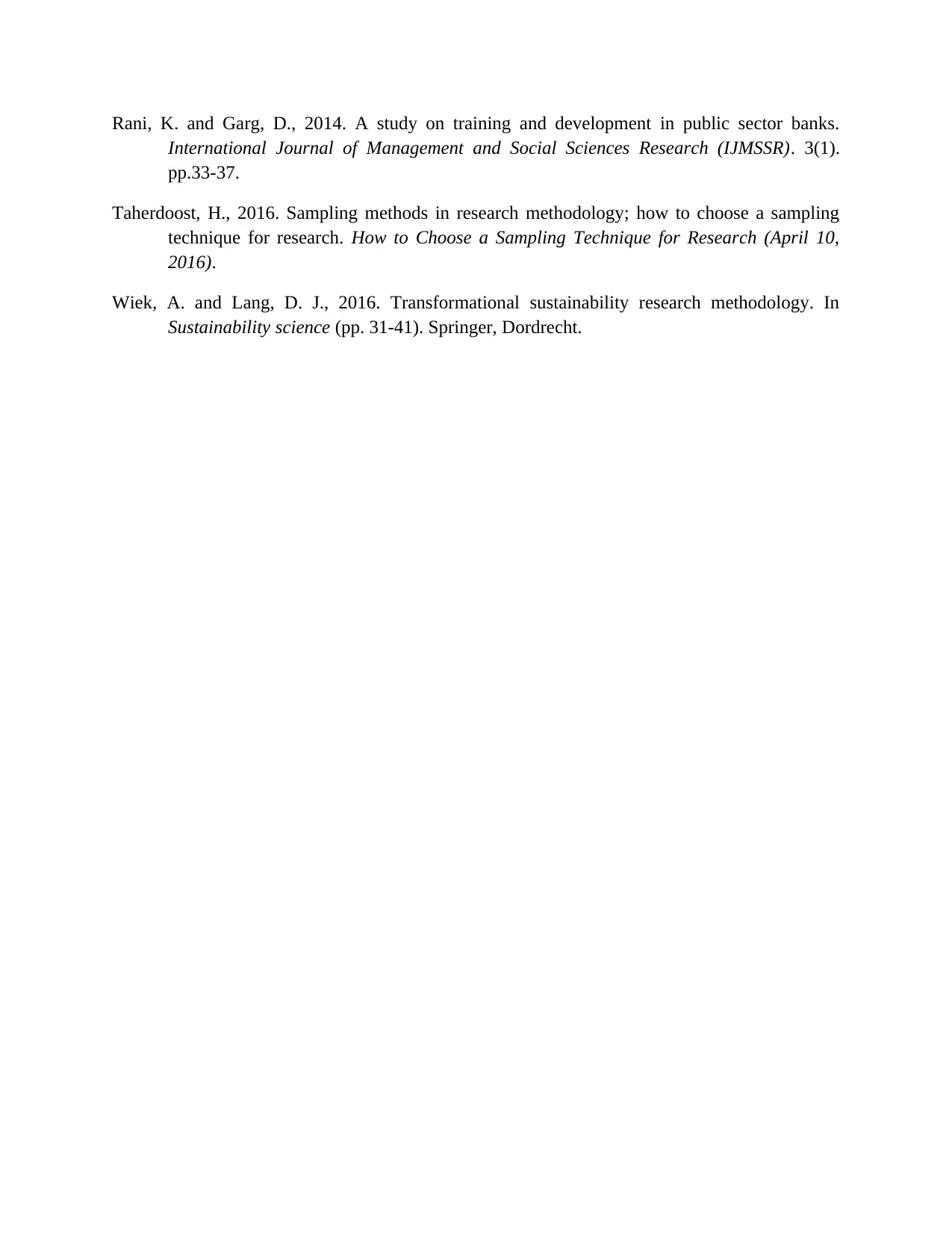
Rani, K. and Garg, D., 2014. A study on training and development in public sector banks.
International Journal of Management and Social Sciences Research (IJMSSR). 3(1).
pp.33-37.
Taherdoost, H., 2016. Sampling methods in research methodology; how to choose a sampling
technique for research. How to Choose a Sampling Technique for Research (April 10,
2016).
Wiek, A. and Lang, D. J., 2016. Transformational sustainability research methodology. In
Sustainability science (pp. 31-41). Springer, Dordrecht.
International Journal of Management and Social Sciences Research (IJMSSR). 3(1).
pp.33-37.
Taherdoost, H., 2016. Sampling methods in research methodology; how to choose a sampling
technique for research. How to Choose a Sampling Technique for Research (April 10,
2016).
Wiek, A. and Lang, D. J., 2016. Transformational sustainability research methodology. In
Sustainability science (pp. 31-41). Springer, Dordrecht.
⊘ This is a preview!⊘
Do you want full access?
Subscribe today to unlock all pages.

Trusted by 1+ million students worldwide
1 out of 9
Related Documents
Your All-in-One AI-Powered Toolkit for Academic Success.
+13062052269
info@desklib.com
Available 24*7 on WhatsApp / Email
![[object Object]](/_next/static/media/star-bottom.7253800d.svg)
Unlock your academic potential
Copyright © 2020–2025 A2Z Services. All Rights Reserved. Developed and managed by ZUCOL.





